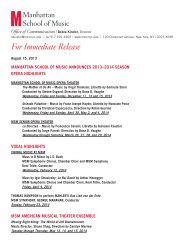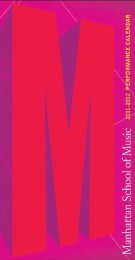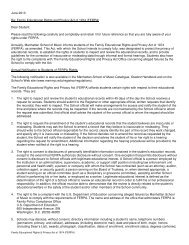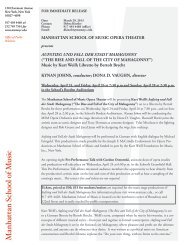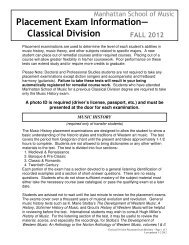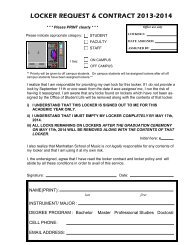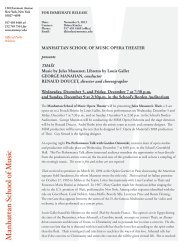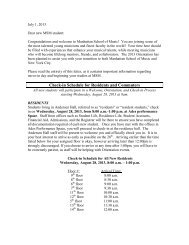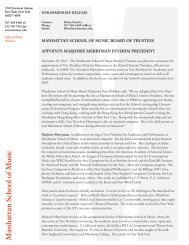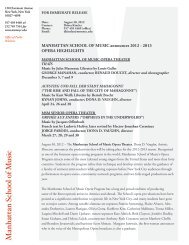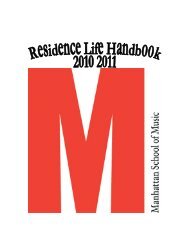Table of Contents - Manhattan School of Music
Table of Contents - Manhattan School of Music
Table of Contents - Manhattan School of Music
- No tags were found...
Create successful ePaper yourself
Turn your PDF publications into a flip-book with our unique Google optimized e-Paper software.
<strong>Table</strong> <strong>of</strong> <strong>Contents</strong>WELCOME 5I. PLACEMENT AUDITIONS FOR ENSEMBLES 71. 1st Semester2. 2nd SemesterII. EXCERPTS FOR ENSEMBLE PLACEMENT AUDITIONS 8III. CURRICULUM 101. PK 2451—2452 Percussion Lab2. Lesson Schedule3. Chris Lamb SeminarsIV. ENSEMBLES 111. Percussion Ensemble2. Jazz Department3. Orchestra Principal PercussionistsV. RECITALS 121. Nonrequired Recitals2. Required Recitals—Undergraduate and Graduate Programs3. Required Recital—Pr<strong>of</strong>essional Studies4. Doctor <strong>of</strong> <strong>Music</strong>al Arts Recitals5. Concerto CompetitionVI. LIBRARY COLLECTION 13VII. INSTRUMENT CARE 13VIII. JURY REQUIREMENTS 141. Freshman Year2. Sophomore Year3. Junior Year4. Senior Year5. Master’s Degree, Year 16. Master’s Degree, Year 2APPENDIX I 17APPENDIX II 233
I. Placement Auditions for EnsemblesAuditions for the school ensembles take place at the beginning <strong>of</strong> each semester.The performance <strong>of</strong>fice has a list <strong>of</strong> the required repertoire. A list is also includedin this handbook.1. 1st SemesterTransferring students, returning students, and graduate students are expected topresent all repertoire from the timpani and percussion audition list. Incoming freshmenshould try to prepare most <strong>of</strong> the repertoire on the list or at least be ready toshow skills on all percussion instruments. The auditions will take place openly sothat the jury can discuss the student’s progress and plans for the year.At the conclusion <strong>of</strong> these auditions the jury will place students in the appropriateensembles.2. 2nd SemesterAll students will be expected to play all excerpts from the audition list. If a studenthas a preference for timpani or percussion, he or she should indicate to the auditionmonitor what will be played first (i.e., either start with timpani as a preference andfinish with percussion, or start with percussion as a preference and finish with timpani).If the student has no preference, this should be indicated to the monitor.This audition will take place behind a screen. The jury will not know who is playing,as there will be no verbal communication between the jury and the student.Each applicant will be rated between 1 and 5 (5 being high, 1 being low). Theperformance <strong>of</strong>fice will average these ratings, and ensemble placement will bestrictly by the numbers recorded by the jury. In the case <strong>of</strong> ties, higher standingwill be given to graduate students and upperclassmen.These two types <strong>of</strong> auditions are to give the students experience in differentaudition environments.67
II. Excerpts for Ensemble Placement AuditionsXylophoneGershwinPorgy and Bess—IntroductionKabalevskyColas BreugnonShostakovichPolkaTimpaniBeethovenBeethovenBrahmsHindemithStravinskyTchaikovskySymphony No. 5—3rd and 4th movementsSymphony No. 9—1st and 2nd movementsSymphony No. 1—opening and 4th movementSymphonic Metamorphosis—2nd movementRite <strong>of</strong> Spring—Danse SacraleSymphony No. 4—1st movementBellsDukasMozartRespighiSnare DrumBartókProk<strong>of</strong>ievProk<strong>of</strong>ievRavelRimsky-KorsakovSorcerer’s ApprenticeMagic FlutePines <strong>of</strong> RomeConcerto for Orchestra—2nd movementPeter and the WolfLt. Kije—Birth <strong>of</strong> Kije and BurialBoleroScheherazade—3rd and 4th movementsCymbalsTchaikovskyRomeo and JulietGeneral crashes at varied dynamicsTambourineTriangleDvorákCarnival OvertureDemonstrate shake and finger roll skillsBrahms Symphony No. 4Demonstrate roll and single note skills89
III. CurriculumIV. Ensembles1. PK 2451—2452 Percussion Lab (Fridays, 3:00 –5:00; Room 610)A full-spectrum approach to percussion performance and practice through sectionals,orchestral repertoire sessions for percussion and timpani, Western and non-Western instrument workshops, and lecture/demonstrations by visiting artists.Instrument maintenance as well as stick construction and mallet wrapping will alsobe discussed.Students are expected to perform regularly in class either in master classes, workshops,or solo performance settings.A number <strong>of</strong> the lab classes are devoted to the Marimba Project. These are performance-orientedclasses where students have the opportunity to play solo andsmall ensemble repertoire for their peers, culminating in a spring concert in whichall students perform.2. Lesson ScheduleThe private lesson teaching schedule is worked out carefully each semester withinput from the primary teacher, secondary teachers, and the student. Each studentshould have a conversation with his or her primary teacher prior to the start <strong>of</strong>each semester regarding goals and plans for that semester. Students may also speakabout this with Mr. Patton, who creates the schedule.3. Chris Lamb SeminarsAll students will participate in these seminars as a part <strong>of</strong> their private-lesson program.There will be four two-hour sessions per semester. Level I, Percussion Skillsand Concepts, is for freshman, sophomores, and first-semester graduate students.Level II, Orchestral Repertoire Seminar, is for juniors, seniors, and grad students.Level I will focus on physical movement that allows the percussionist the freedom tocontinually absorb new techniques required for the growing number <strong>of</strong> percussioninstruments. Emphasis on how technique affects tone production will be made, andspeed and control will begin to be observed. In Level II, application <strong>of</strong> the fundamentals<strong>of</strong> technique, touch, and tone production will be made to specific orchestralrepertoire for all instruments, always keeping in mind the musical directives <strong>of</strong> thecomposer. Both classes will include a packet <strong>of</strong> material designed to guide the studentin practicing the topics and ideas presented in the classes.1. Percussion EnsembleThe <strong>Manhattan</strong> Percussion and Contemporary Ensembles are designed to helpbridge the gap between school and pr<strong>of</strong>essional life, with special emphasis onachieving a high level <strong>of</strong> playing ability and concentration, artistic satisfaction, andkinetic opportunities.Students are able to: 1) gain hands-on experience, 2) work under a conductor,3) expand their knowledge <strong>of</strong> the literature, and 4) apply the skills they havelearned in their lessons and in the practice room.Concerts include masterpieces from the repertoire (Cage, Varèse, Boulez, Stravinsky,etc.) as well as new works by young composers. A wide variety <strong>of</strong> styles are programmedincluding minimal music (Reich, Glass, etc.), 12-tone music (Carter, Babbitt, etc.), spatialmusic (Cage, Foss, etc.), tonal music, and improvisation.2. Jazz DepartmentThere are opportunities for classical percussion majors to participate in the excellent<strong>Manhattan</strong> <strong>School</strong> <strong>of</strong> <strong>Music</strong> jazz department, and this is encouraged. Studentsmay audition for ensembles, take lessons and/or courses with jazz faculty, attendmaster classes, and, <strong>of</strong> course, play informally with students from the jazz department.For ensemble audition information, check with Mr. DiCioccio. To schedulelessons with jazz percussion faculty, speak first with Mr. Patton.3. Orchestra Principal PercussionistsWhoever is assigned as a principal percussionist in either orchestra for a givensemester has responsibility for dividing and assigning <strong>of</strong> parts, and for insuringthat necessary instruments are in place for all rehearsals and concerts. Just as a pr<strong>of</strong>essionalprincipal percussionist would, you must work closely and in a timely waywith the supervisor <strong>of</strong> instruments (Ms. Heldrich), the stage manager, the orchestramanager, the librarian, the conductor, and your section colleagues.1011
1. Nonrequired RecitalsV. RecitalsStudents are encouraged to give recitals in nongraduating years. Consult withyour teacher for approval. Most nongraduating recitals are given in the fall semesterwhen recital space is at less <strong>of</strong> a premium. The scheduling coordinator isresponsible for the assignment <strong>of</strong> recital space and other related details. Studentsare responsible for providing their own accompanists.2. Required Recitals—Undergraduate and Graduate ProgramsStudents expecting to graduate from either program during the current school yearare required to give a graduation recital in addition to the graduation jury. (Studentsenrolled in the graduate Orchestral Performance Program are not required to give arecital.) Consult the scheduling coordinator in scheduling a graduation recital. Therecital approval form, available from the scheduling coordinator, requires the approvaland signatures <strong>of</strong> your teacher and the chairman. The teacher’s signature implies thatthe student is prepared to perform. Once the major teacher has signed the form, theteacher is not permitted to request a postponement <strong>of</strong> the recital. The chairman’s signaturesignifies the approval <strong>of</strong> the repertoire and programming. The chairman will notsign a recital approval form until the major teacher has done so. Students should becertain that the program is accurately written before submitting it for signatures. Therecital approval form is to be filed with the scheduling coordinator and the chairman atleast four weeks prior to the recital date. Students must be enrolled for major lessonsuntil the graduation recital and graduation jury (as applicable) have been successfullycompleted. A graduation recital and/or graduation jury does not serve as a substitutefor an entrance examination to a higher degree program. Students are responsible forproviding their own accompanists.3. Required Recital—Pr<strong>of</strong>essional StudiesConsult the scheduling coordinator in scheduling the recital and file the recitalapproval form (see previous paragraph). Notify the <strong>of</strong>fice <strong>of</strong> the registrar and thechairman at least four weeks prior to your scheduled recital in order for facultyadjudication <strong>of</strong> the recital to be arranged. In some cases it may be necessary for thestudent to have the recital taped for later adjudication. Students are responsible forproviding their own accompanists.4. Doctor <strong>of</strong> <strong>Music</strong>al Arts RecitalsConsult the director <strong>of</strong> doctoral studies for procedures and requirements.5. Concerto CompetitionA concerto competition for interested <strong>Manhattan</strong> <strong>School</strong> <strong>of</strong> <strong>Music</strong> students takesplace in the spring <strong>of</strong> each year. Please discuss your interest in the competition withyour teachers and the department chair.VI. Library CollectionThe library has a policy <strong>of</strong> purchasing new solo literature as well as standard percussionbooks for use. Each year, new music will be added to the collection. Percussionperiodicals are also being made available. Please make good use <strong>of</strong> our library, as yourinterest will support the continuation <strong>of</strong> this policy. Students should feel free to makerecommendations <strong>of</strong> percussion literature for library acquisition through the departmentchair.VII. Instrument CareMuch thought goes into building the instrument collection at <strong>Manhattan</strong> <strong>School</strong><strong>of</strong> <strong>Music</strong>, but responsibility for the equipment care begins and ends with the students.Any abuse or misuse <strong>of</strong> percussion instruments causes an unnecessary financialburden on the department and negatively affects not only your educationalexperience but also that <strong>of</strong> future generations <strong>of</strong> <strong>Manhattan</strong> <strong>School</strong> <strong>of</strong> <strong>Music</strong> percussionists.Take care in moving equipment—especially mallet instruments—over andthrough doorways. Cover instruments after using them. Be considerate. Alwayslock studios and practice rooms.No one may perform fine-tuning <strong>of</strong> timpani heads unless they have studied thisand been granted permission by Mr. Patton. Any problems related to instrumentmaintenance should be reported promptly to Ms. Heldrich.1213
1. Freshman YearVIII. Jury RequirementsI. SNARE DRUMa. Rolls at various dynamics and varying degrees <strong>of</strong> open or closedb. Rudimentsc. Excerpt examples from * “Year 1”d. Solo selectionII. MALLETSa. Scales (major and minor)b. Arpeggios, 2 octaves (major and minor)c. Excerpt examples from * “Year 1”d. Solo selectionIII. TIMPANIa. Excerpts from * “Year 1”b. Etude selection2. Sophomore YearI. SNARE DRUMa. Excerpts from * “Year 2”b. Solo selectionII. MALLETSa. Excerpts from * “Year 2”b. Solo selection or selections (at least one to show four-mallet skills)c. Sight reading skills—two malletsIII. TIMPANIa. Excerpts from * “Year 2”b. Solo selectionIV. ACCESSORIESa. Cymbal, triangle, tambourine, bass drum skills (choose two instruments)b. Excerpts from * “Year 2”3. Junior YearI. SNARE DRUMa. Excerpts from * “Year 3”b. Solo or etude selection (optional)II. MALLETSa. Excerpts from * “Year 3”b. Four-mallet workc. Sight readingIII. TIMPANIa. Excerpts from * “Year 3”b. Solo selection (to show tuning and/or pedaling abilities)IV. ACCESSORIESa. Cymbal, triangle, tambourine, bass drum skills (choose two instrumentsdifferent from sophomore year)b. Castanet skillsc. Excerpts on accessories from * “Year 1–4”V. MULTI-PERCUSSION WORK—published or self-composed (junior orsenior year)4. Senior YearI. SNARE DRUMa. Review <strong>of</strong> excerpts from * “Year 1–4”b. Sight readingII. MALLETSa. Excerpts from * “Year 4”b. Selection (your choice)III. TIMPANIa. Excerpts from * “Year 4”IV. MULTI-PERCUSSION WORK—published or self-composed (junior andsenior year)* See Appendix I1415
5. Master’s Degree, Year 1a. Show extensive knowledge <strong>of</strong> orchestral repertoire from * “Year 1–4”b. Prepare “mini-recital’—to include multi-percussion, timpani, and keyboardpercussion6. Master’s Degree, Year 2a. Orchestral and operatic excerpts at a pr<strong>of</strong>essional levelb. Be prepared to play selections from recital program* See Appendix IAppendix IThe percussion department at <strong>Manhattan</strong> <strong>School</strong> <strong>of</strong> <strong>Music</strong> is interested in providingits students with foundational skills and opportunities to prepare them forany area <strong>of</strong> pr<strong>of</strong>essional music-making. Any interest a student might have in ethnic,contemporary, jazz, solo, ensemble, or orchestral percussion will be encouragedby the entire percussion faculty.The following lists contain suggested orchestral timpani and percussion excerptsfor both undergraduate and graduate students. (Some nonorchestral works are listedas well.) These lists are included in this handbook to give students some guidelinesto studying only one small area <strong>of</strong> percussion performance. The excerpts neednot be studied in the given order—that can be discussed between the student andteacher. But it is suggested that all students be familiar with all excerpts by the timethey graduate.TimpaniYEAR 1VariousOverturesBeethoven Symphonies 1 and 2MozartSymphoniesYEAR 2Beethoven Symphonies 3–9MendelssohnSymphoniesSchumannSymphoniesYEAR 3BrahmsDvorákStraussTchaikovskySymphoniesSymphoniesTone PoemsSymphonies16YEAR 4BartókHindemithMahlerSibeliusStravinskyConcerto for OrchestraSymphonic MetamorphosisSymphoniesSymphoniesRite <strong>of</strong> Spring17
MASTER’S DEGREEReview <strong>of</strong> 19th-Century RepertoireOperatic RepertoireBarberBartókBrittenCoplandShostakovichStravinskyPercussionYEAR 1SNARE DRUMBartókBrittenProk<strong>of</strong>ievRavelRossiniXYLOPHONEBrittenKabalevskyKhachaturianRavelSaint-SaënsShostakovichBELLSMozartStraussTchaikovskyWagnerCYMBALSTchaikovskyWagnerConcerto for OrchestraYoung Person’s Guide to the OrchestraPeter and the WolfBoleroOverture to La gazza ladraYoung Person’s GuideColas BreugnonDance <strong>of</strong> the Rose MaidensMother GooseDanse MacabrePolka from the Golden AgeMagic FluteDon JuanSleeping BeautyDance <strong>of</strong> the Apprentices, Rhine JourneyRomeo and JulietRide <strong>of</strong> the Valkyries18TAMBOURINEBerliozRoman Carnival OvertureBrahms Symphony No. 4Liszt Piano Concerto No. 1YEAR 2SNARE DRUMRimsky-Korsakov ScheherazadeProk<strong>of</strong>ievLt. KijeSchuman, Wm. Symphony No. 3XYLOPHONECoplandGershwinStraussStravinskyBELLSDebussyDukasProk<strong>of</strong>ievRespighiBilly the Kid, Appalachian Spring, HoedownPorgy and BessSalomePetrouchkaLa MerSorcerer’s ApprenticeAlexander NevskyPines <strong>of</strong> RomeCYMBALSMozartAbduction from the SeraglioRachmanin<strong>of</strong>f Piano Concerto No. 2Tchaikovsky Symphonies 4–6TAMBOURINEBorodinChabrierRimsky-KorsokovTRIANGLEBizetDvorákPolovetsian DancesEspañaScheherazadeCarmen SuiteNew World Symphony19
BASS DRUMMahler Symphonies 2 and 3StravinskyRite <strong>of</strong> SpringTRIANGLERimsky-KorsakovWagnerScheherazadePrelude to Die MeistersingerMULTI-PERCUSSIONBernsteinWest Side StoryCASTANETSProk<strong>of</strong>iev Piano Concerto No. 3WagnerTannhäuserYEAR 3SNARE DRUMKodályHáry JánosProk<strong>of</strong>iev Symphony No. 5RavelRapsodie EspagnoleRimsky-Korsakov Capriccio EspagnoleShostakovich Symphony No. 10XYLOPHONEBartók<strong>Music</strong> for Strings, Percussion and CelesteBernsteinWest Side StoryGershwinAmerican in ParisKodályHáry JánosBELLSGlazunovViolin ConcertoHolstThe PlanetsKodályHáry JánosRimsky-Korsakov Russian Easter OvertureCYMBALSDebussyFêtes, La MerMussorgskyNight on Bald MountainSibeliusFinlandiaTAMBOURINEDebussyIbériaGriegArabian Dance from Peer GyntStravinskyPetrouchka20BASS DRUM AND CYMBAL HOOK-UPMahler Symphony No. 1StravinskyPetrouchkaMULTI-PERCUSSIONStravinskyVIBESBernsteinYEAR 4SNARE DRUMSousaStrauss, J.NielsenL’Histoire du soldatWest Side StoryStars and Stripes Forever (styles)Die Fledermaus, Kaiser Waltz (styles)Symphony No. 5, Clarinet ConcertoXYLOPHONEBarberMedea’s MeditationMessiaenExotic BirdsSchuman, Wm. Symphony No. 3StravinskyFirebird (complete), Les NocesBELLSMessiaenExotic BirdsProk<strong>of</strong>iev Piano Concerto No. 1StravinskyPetrouchkaWagnerWaldweben21
CHIMESMessiaenEt Expecto Resurrectionem MortuorumAppendix IICYMBALS, TAMBOURINE, TRIANGLERefine skills and styles learned in first three yearsDevelop personal styleBASS DRUMBartók, Mahler, Prok<strong>of</strong>iev, etc. (sounds and styles)MULTI-PERCUSSIONBartókSonata for Two Pianos and PercussionDoctoral StudiesTHREE RECITALSExtensive skills on all mallet instrumentsVast knowledge <strong>of</strong> multi-percussion repertoireTIMPANIComprehensive knowledge <strong>of</strong> 20th-century orchestral repertoireOperatic repertoireSolo repertoirePERCUSSIONComprehensive knowledge <strong>of</strong> 20th-century orchestral repertoireSolo repertoire2223



